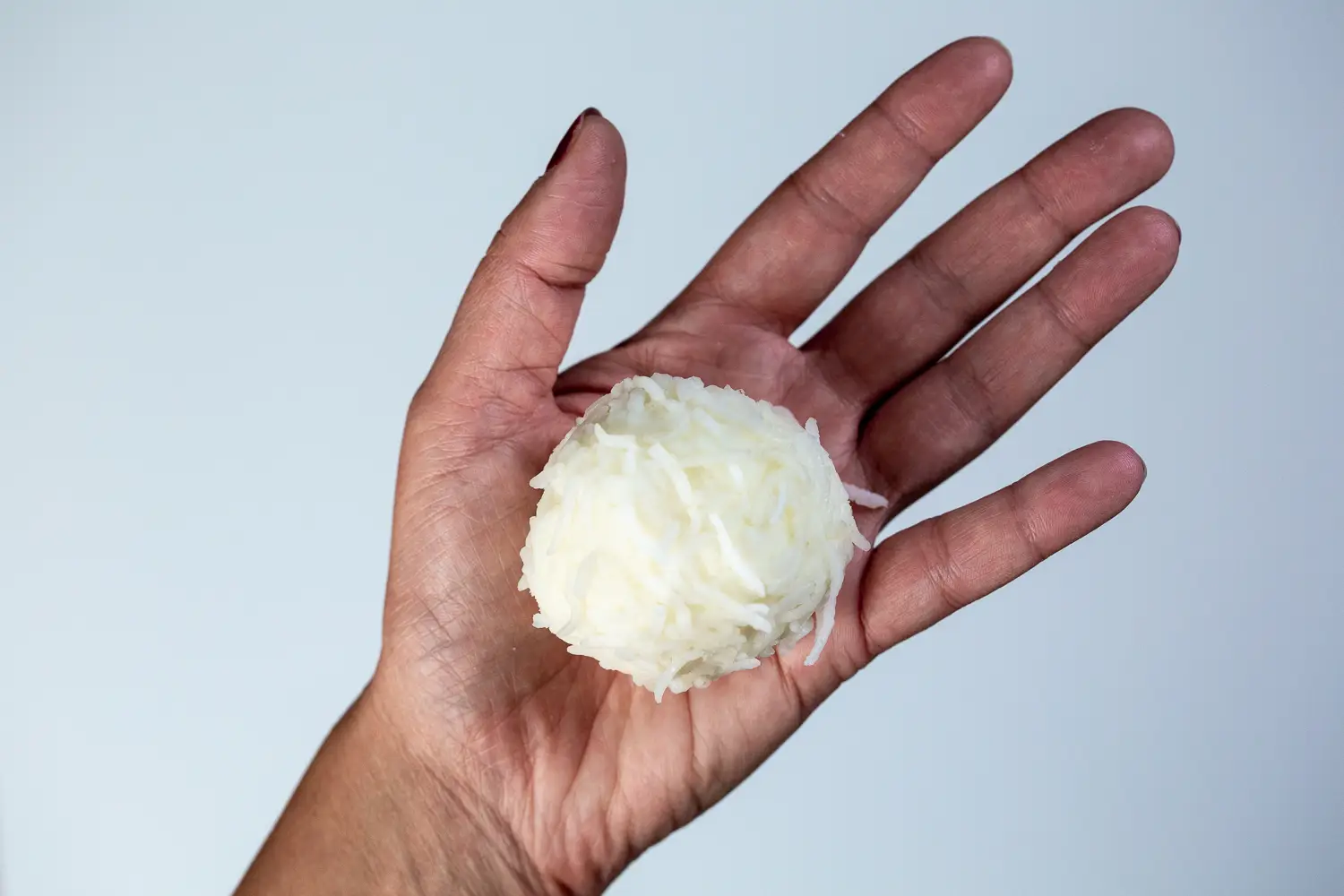Access our First Foods® Database in the Solid Starts App.
Learn moreRice
Grain
Age Suggestion
6 months
Iron-Rich
No
Common Allergen
No

When can babies have rice?
Rice may be introduced as soon as baby is ready to start solids, which is generally around 6 months of age.
Rice was domesticated in Asia thousands of years ago, and today it is a beloved staple food for nearly half of the world’s population. While “brown rice” and “white rice” are common ingredients across cultures, rice is actually incredibly diverse in flavor and origin. Arborio rice, basmati rice, bomba rice, sticky rice—there are more than 100,000 varieties in this diverse family of grasses, and each has distinct tastes and culinary applications.
How do you serve rice to babies?
Every baby develops on their own timeline, and the suggestions on how to cut or prepare particular foods are generalizations for a broad audience.
6 months old +:
Mix moist, cooked rice into sauces or other liquids to make it scoopable and easier for young babies to manage. Alternatively, make a thick congee or porridge by cooking rice with broth, coconut milk, or another liquid. Let baby scoop with their hands or offer a pre-loaded spoon for the child to grab from you. You can also use cooked rice to form large, soft balls that baby can pick up and munch on. Chopped rice noodles are another great way to introduce rice to baby. If you want to share a thin puffed rice cake, consider spreading it with a thin layer of a favorite dip, like bean dip or mashed avocado. If offering infant rice cereal regularly, consider incorporating oat or multigrain infant cereals in your meal rotation too, in order to reduce the risk of accidental exposure to heavy metals like arsenic in rice cereal. Wait to offer mochi, nian, gao, tteok, and other steamed rice cakes, as these pose an increased choking risk due to their thick, springy consistency and often cylindrical shapes.
9 months old +:
Offer moist, cooked rice as desired: plain and on its own, rolled into balls for the child to pick up and practice biting, or as part of a shared meal. When serving rice on its own, flattening the grains with the back of a fork can help the rice stick together and make it easier for babies to self-feed. Try recipes for arancini, onigiri, sticky rice, or any dish that can be formed into a patty.
18 months old +:
Serve rice as desired, either on its own or as part of a shared meal. Serve alongside an age-appropriate utensil like trainer chopsticks or a fork and pre-load the utensil as needed. Don’t be surprised if the toddler continues to use their hands. Rice can be tricky to pick up with utensils, so consider making the rice stickier and moister to help the child have more success with the utensil.
3 years old +:
Serve rice as desired, on its own or as part of a shared meal. At this age, you can also begin to introduce mochi, nian gao, tteok, and other steamed rice cakes cut into quarters lengthwise so they are no longer round. When serving these steamed rice cakes, make sure the child is seated and supervised in a safe eating environment, as many of these kinds of foods pose a high choking risk.

Some tips for serving rice to babies 6 months +
Videos
Is rice a choking hazard for babies?
No. Cooked grains of rice present a low risk when safely prepared for a child’s age and developmental ability, though, in theory, an individual could choke on any food. That said, rice products like mochi and other steamed rice cakes are a common cause of choking in some regions, due to their chewy, dense, and sticky consistency. To reduce the risk, prepare and serve rice in an age-appropriate way as described in the How to Serve section. Note that loose grains of rice are more likely to scatter in the mouth, which can cause gagging or coughing. If baby is struggling to manage the food, consider mashing the grains with the back of a fork or adding ingredients like broth, coconut milk, or sauce to help the grains stick together. As always, create a safe eating environment and stay within reach of baby during meals.
Learn the signs of choking and more about choking first aid in our free guides, Infant Rescue and Toddler Rescue.
Is rice a common allergen?
No. Rice is not a common IgE-mediated food allergen. However, rice is a known trigger for FPIES—food protein-induced enterocolitis syndrome, an increasingly recognized non-IgE mediated food allergy in children that can be severe and life-threatening. Unlike most food allergy reactions that occur within minutes of contact with a specific food trigger, FPIES allergic reactions occur within hours after consuming a particular food. For this reason, FPIES is sometimes known as a delayed food allergy. Symptoms include delayed vomiting (typically 1 to 4 hours after ingesting the food trigger) and/or experiencing diarrhea 5 to 10 hours after ingestion. Other symptoms include low blood pressure, low body temperature, extreme pallor, repetitive vomiting, and significant dehydration. Thankfully, most cases of FPIES will completely resolve during toddlerhood. Children who have been diagnosed with FPIES must be followed closely by an allergist or pediatric gastroenterologist. If baby has pre-existing FPIES to another food, talk to your allergist about how best to introduce other solid foods that may have a higher risk for inducing FPIES.
As you would when introducing any new food, start by offering a small quantity of rice for the first few servings. If there is no adverse reaction, gradually increase the serving size over future meals.
Is rice healthy for babies?
Yes. Rice is an excellent source of carbohydrates to provide quick energy, and enriched white rice offers great amounts of folate and a dash of iron. Generally speaking, brown rice and other whole-grain varieties of rice contain more protein, vitamins, and minerals than white rice. Rice and processed rice products like infant rice cereal can contain varying amounts of arsenic, a heavy metal the grain soaks up from the environment in which it grows that can cause negative health effects when consumed in great excess. In general, you need not be concerned with baby consuming rice as one of a variety of foods in the diet.
Is brown rice or white rice better for babies?
Both white and brown rice can be a part of a balanced and healthy diet for babies. While brown rice tends to have more arsenic than white rice, it also offers more vitamins and minerals. White rice commonly has less arsenic but fewer nutrients. Aim to include rice as a part of a variety of foods in baby’s diet.
What's the best infant cereal?
If you would like to offer infant cereals, consider an iron-fortified oat or multigrain cereal. Infant cereals made with oats, wheat, or a combination of grains can help reduce the risk of accidental exposure to heavy metals like arsenic in rice cereal. You can also serve warm cereals made with alternative grains that tend to have less arsenic, including amaranth seed, barley, bulgur (wheat), corn, farro (wheat), or millet. Store-bought fortified infant rice cereal is a common first food in some regions, but there’s no developmental or nutritional need to start solids with infant cereal. There are lots of age-appropriate, iron-rich first foods to help baby meet their early nutritional needs.
What's the best rice cake for babies?
In general, we look for thin, soft multi-grain “rice” cakes or teething rusks that soften easily on contact with saliva and do not rely solely on rice as an ingredient. Examples include Suzie’s corn and quinoa cakes or Lundberg’s whole grain cakes. This information is not sponsored—we simply want to give you examples as a starting point in your research. Avoid rice crackers, thick puffed rice cakes, and steamed rice cakes such as mochi, all of which pose a higher choking risk.
Why does rice contain arsenic?
Rice (along with many fruits, vegetables, and other edible plants) has trace amounts of arsenic due to arsenic present in the water and soil in which the plant grows. Arsenic gets into the soil and water through the use of arsenic-based pesticides, animal feeds, fertilizers, and other contaminants, and once there, the arsenic is absorbed by the plants growing in that area. The amount of contamination varies by location, and as a result, the amount of arsenic in rice depends on where it grew and how it was processed.
Which rice is lowest in arsenic?
Generally, white or polished rice tends to be lower in arsenic compared to brown rice. This is because arsenic is more concentrated in the grain’s outer layer, which is stripped off to make white rice. Varieties like white basmati rice and white sushi rice generally tend to be lower in arsenic, although it varies by region.
Is organic rice lower in arsenic than conventional rice?
Not necessarily. Organically-grown rice absorbs arsenic in the same way as conventionally-grown rice. Arsenic levels depend on where the rice was grown, and even organic rice can be exposed to environmental arsenic.
Which rice alternatives are lowest in arsenic?
Many grain varieties are low in arsenic, like amaranth, barley, buckwheat, bulgur, corn, farro, millet, polenta, quinoa, and teff. Generally, these alternatives are lower in arsenic than rice, although quantities vary depending on where the plants grew. Including these grains in your rotation of foods is a helpful way to incorporate more variety, help expose baby to new foods, and reduce baby’s arsenic exposure.
Our Team
Written by
Expert Tips Delivered to Your Inbox
Sign up for weekly tips, recipes and more!
Copyright © 2025 • Solid Starts Inc







